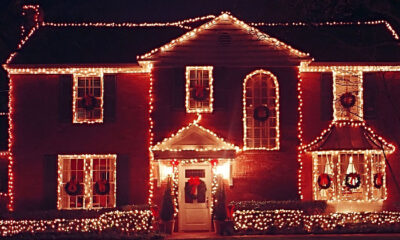CURB APPEAL IN WINTER
How to Hang Christmas Lights

There are several modern methods for hanging Christmas lights. Some of these include using extension cords and cheap glue. Others require professional assistance. It all depends on your specific requirements. In this article, we will discuss both vertical and horizontal methods. We’ll also discuss different materials that are suitable for hanging Christmas lights.
Modern methods of hanging christmas lights
There are many modern methods of hanging Christmas lights. You can use a staple gun or plastic clips to attach the lights to your roof or siding. Both methods are relatively easy to use and don’t require any special tools. Plastic clips are particularly useful for roofs and are inexpensive and easy to remove once the holiday season is over. They can accommodate all types of Christmas lights.
If you’re hanging lights from a tree, the most common method is to start at the bottom branch near the trunk and work your way upward. Pull the light strand until it reaches the tip of the branch, then back to the trunk. When you finish the circle, move to the next branch to the right.
Another modern method is to use pushpins. These come in a variety of styles and colors, including clear, brass, and plastic. Some are in fun shapes and are easier to install than nails. Pushpins also leave very small holes in walls, which make them less noticeable than nails and are easier to patch. Using pushpins also allows you to keep the lights up year-round. You can also change them out to match the holiday season.
Christmas lights are a staple of the holiday season, but there are safer and better ways to hang them. Holiday lighting can be hazardous, so it is wise to be careful. If you’re going to place lights on the roof, make sure you know how to use them properly. This will ensure they don’t burn your roof.
Before hanging the lights, you should first determine where you’d like to place them. It’s also helpful to identify the focal point. You can use this point to give the entire arrangement purpose.
Horizontal and vertical methods
The difference between horizontal and vertical methods for hanging Christmas lights is that horizontal methods create swirling patterns on the tree’s surface, while the vertical method produces a more even coverage on the tree. The horizontal method is time-consuming to complete, and it leaves gaps in the tree that are hard to fill with extra lights.
Before installing Christmas lights, draw a basic plan of where you’d like to hang them. You should also plan to install heavy-duty extension cords that plug into a 120-volt outlet. You can also use a timer or switch-controlled outlet to automate the process.
There are several different places on your home where you can hang your Christmas lights. Because of this, make sure to check the weather conditions before hanging them. Climbing ladders in poor weather will increase the risk of falling, and it’s much harder to see properly while hanging lights. Also, make sure to work in a well-lit area to avoid potential injuries.
If you’re using lights on a non-white wall, you can use wall-safe tape to secure them. A good way to attach clips is to place one clip on the bottom, one on the top, and one on the left. Then, insert the strands of lights into the arrangement of clips. Repeat this procedure for the remaining strands.
The most traditional way to hang Christmas lights is with a horizontal approach. Using the horizontal method, you’ll travel around the tree while stringing the lights. This method has a disadvantage in that it leaves a dead zone in the lights as you connect them. However, this dead zone can be hidden by inserting the plug deep into the branches.
Using extension cords
If you’re a DIY Christmas light enthusiast, extension cords are an essential part of your toolkit. They are great for securing lights to bushes, walls, and other high places. Just make sure to choose a heavy-duty extension cord that’s rated for outdoor use. Be careful not to stretch the cords across walkways, or place them in low spots where they could become puddles if it rains.
Before using extension cords to hang Christmas lights, make sure you purchase the right size and voltage for the lights that you want to hang. Overloading the cord can cause it to overheat and possibly catch fire. Also, check the insulation to make sure it’s still in good condition. If the insulation is damaged, you should dispose of the cords properly.
The packaging of an extension cord will tell you how much amperage it can handle. Amperage is the highest amount of power or current that can be delivered through it. Don’t exceed the amperage rating of your cord because it can cause it to overheat or break.
Before hanging Christmas lights, be sure to untangle any loose ends and check that both ends are facing the same direction. You may need to use a Quik Klip or a small nail to secure the lights to the tree trunk. If the wire is thinner, you can use a staple gun to secure the light strings to the tree trunk.
Using cheap glue
If you want to hang Christmas lights on your home, there are several methods you can use. You may have tried some of them before, but if you are new to this process, you may be wondering which is best. One of the best and easiest methods is to use a hot glue gun.
This method is very fast and convenient, but it may leave a residue behind. This residue will be worn off over time by UV light, wind, and rain. In addition, it is also very difficult to remove. For that reason, hot glue is only a good option if you intend to keep the lights up all year round.
Another method that works well for hanging Christmas lights on concrete is to use a hot glue gun. First, measure the distance you need to cover with the lights, and then hold the glue gun over the area. Next, place the strand of lights over the hot glue. Be sure to work with a foot-long area at a time.
Another method to hang Christmas lights without nails is to use plastic hooks. These can be used on roofs, gutters, and siding. To ensure that they stay where you want them, make sure that the distance between the plastic hooks is at least six to eight inches. This will ensure a cleaner display.
You can also use adhesive hooks. These are available at home improvement stores and online retailers. However, the problem with these methods is that they may leave a residue when you remove them. Also, if you have a brick wall, using staples might not work. Moreover, if your wall is painted, using adhesive hooks may strip the paint.
Testing lights before you hang them
Before hanging your Christmas lights, you should check to make sure they are in working order. To do this, use a bulb test kit to check each bulb to make sure it is intact. You should also check the ladder carefully and use a wooden or fiberglass one instead of a metal one, which can conduct electricity.
Ensure that there are no loose or damaged parts, as this can compromise the entire lighting system, causing a safety hazard for you and your family. New lights should be labeled for outdoor use and state how many strands of lights are safe to connect. Depending on the brand, you may want to buy between twenty-five and thirty-five strands.
It’s also a good idea to plan where you’d like your Christmas lights to hang. First, measure the area you’d like to cover with the lights. Next, measure the distance from each location to the power source. Once you’ve measured the distances, you can then calculate how many strands you’ll need to cover the space.
If the lights are out, you may need to check the first and last bulbs in the string. Sometimes, a blown fuse will knock out the entire string. If this is the case, you can test the rest of the lights in the string. During this process, you should also make sure to check the power plug. If one of the fuses is bad, you’ll need to replace it.
Before hanging your Christmas lights, you should check each strand for function. Make sure there are no loose bulbs or frayed wires. If the bulbs do not fit properly, they will stop working. Also, make sure you check the plugs and electrical outlet before hanging the strands. If you have trouble finding the right plugs, you can test them by using a light tester. A light tester will send a pulse to the bulbs of each strand.













